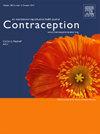评估注重健康公平的质量改进对避孕护理筛查、咨询和提供的影响
IF 2.3
2区 医学
Q1 OBSTETRICS & GYNECOLOGY
引用次数: 0
摘要
目标提高避孕护理质量对于优化人们的生殖健康和实现生殖健康公平至关重要。我们评估了以健康公平为重点的质量改进学习合作(QILC)通过创新的、以人为本的绩效测量方法对社区卫生中心(CHCs)避孕护理质量的影响。方法我们开发了一个为期九个月的 QILC,其中包括关于生殖健康公平和以人为本的避孕护理的每月学习课程、支持资源和策略、同伴学习机会以及技术援助。社区健康中心在 QILC 结束前向患者收集了 "以人为本的避孕咨询"(PCCC)测量调查,以评估避孕咨询情况。社区健康中心在其电子健康记录(EHR)中采用了一种新颖的基于健康服务需求的避孕筛查问题,即 "自我避孕需求"(SINC)。通过提取电子病历数据来计算避孕药具使用情况的标准化电子临床质量标准(eCQMs)。为了评估干预效果,我们比较了 PCCC 分数、通过 SINC 筛查的合格患者百分比以及 QILC 实施前后的避孕药具使用情况。在终点线上,10 家社区健康中心中有 6 家的 PCCC 得分有所提高(Δ 2% 至 24%),其中 4 家超过了 80% 的优质护理基准。基线时,很少有患者接受 SINC 筛查(范围:1% - 36%)。在所有医疗点中,符合筛查条件的患者比例中位数增加了 10%(范围:1% - 46%)。各医疗点观察到使用最有效或中等有效避孕方法的 eCQMs 有所增加(mdn 变化:2%;范围:[<1% -9%])。本文章由计算机程序翻译,如有差异,请以英文原文为准。
ASSESSING THE IMPACT OF HEALTH EQUITY-INFORMED QUALITY IMPROVEMENT ON CONTRACEPTIVE CARE SCREENING, COUNSELING, AND PROVISION
Objectives
Improving contraceptive care quality is crucial to optimizing people’s reproductive health and achieving reproductive health equity. We assessed the impact of a health equity-focused quality improvement learning collaborative (QILC) on the quality of contraceptive care at community health centers (CHCs) through innovative, person-centered performance measurement.
Methods
We developed a nine-month QILC comprising monthly learning sessions on reproductive health equity and person-centered contraceptive care, supporting resources and strategies, peer-learning opportunities, and technical assistance. CHCs collected Person-Centered Contraceptive Counseling (PCCC) measure surveys from patients pre-post QILC to assess contraceptive counseling. CHCs implemented a novel health service needs-based contraception screening question, the Self-Identified Need for Contraception (SINC), into their EHRs. EHR data were extracted to calculate standardized electronic clinical quality measures (eCQMs) of contraceptive use. To assess intervention impact, we compared PCCC scores, percentage of eligible patients screened with SINC, and contraceptive use before and after the QILC.
Results
Baseline PCCC scores ranged from 30% to 94%. At endline, 6 of 10 CHCs improved their PCCC score (Δ 2% to 24%) and four of those surpassed the 80% benchmark for high-quality care. At baseline, few patients were screened with SINC (range: <1% - 36%). Across sites, median increase in percentage of eligible patients screened was 10% (range: <1% - 46%). Sites observed an increase in eCQMs for use of most or moderately effective contraceptive methods (mdn change: 2%; range: [<1% -9%).
Conclusions
Participation in an equity-focused and performance measures-driven QILC led to increased person-centered screening for contraceptive need and improved contraceptive counseling.
求助全文
通过发布文献求助,成功后即可免费获取论文全文。
去求助
来源期刊

Contraception
医学-妇产科学
CiteScore
4.70
自引率
17.20%
发文量
211
审稿时长
69 days
期刊介绍:
Contraception has an open access mirror journal Contraception: X, sharing the same aims and scope, editorial team, submission system and rigorous peer review.
The journal Contraception wishes to advance reproductive health through the rapid publication of the best and most interesting new scholarship regarding contraception and related fields such as abortion. The journal welcomes manuscripts from investigators working in the laboratory, clinical and social sciences, as well as public health and health professions education.
 求助内容:
求助内容: 应助结果提醒方式:
应助结果提醒方式:


